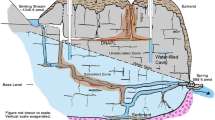Abstract
A train derailment near Lewisburg, Tennessee, in October 1990 prompted two series of groundwater investigations. The first was to determine the subsurface flow route of chloroform and styrene that sank into the underlying karst aquifer. The second was to determine the source of contamination for two nearby residential wells which were found to be contaminated with trichloroethylene (TCE). Water-sample analysis and a dye trace performed at the time of the train derailment indicated groundwater flow to Wilson Spring. A dam was constructed to contain the entire discharge from the spring so that it could be treated before being discharged into Big Rock Creek. Three springs and three water wells were contaminated with chloroform and styrene. Dye traces were performed to determine groundwater flow directions in the vicinities of the TCE-contaminated wells and in the vicinities of potential sources. At the train derailment, the chloroform and styrene sank into the Upper Ridley Karst Aquifer and pooled on top of the Lower Ridley Confining Layer. An exploratory well revealed a layer of chloroform (a Dense Non-Aqueous Phase Liquid DNAPL) on the bottom, a layer of groundwater in the middle, and a layer of styrene (a Light Non-Aqueous Phase Liquid LNAPL) on top. Groundwater with relatively low levels of chloroform and styrene in solution was carried by a small cave stream southeast along the strike to Wilson Spring. Chloroform product moved by gravity southwest down-dip along weathered bedding planes. Treatment of contaminated groundwater from Wilson Spring and recovery wells at the spill site has occurred continuously since October, 1990.
Similar content being viewed by others
References
Crawford NC (1982) Karst Hydrogeology of Tennessee. Guidebook prepared for US Environmental Protection Agency Karst Hydrogeology Workshop, Nashville, Tennessee. 102 pp, 5 plates
Crawford NC (1988) Karst hydrology investigation in the vicinity of the Campus-Injector Complex for the proposed Middle Tennessee Site of the Superconducting Super Collider. 179 pp, 7 plates. In: Crawford NC, and Barr TC (Eds), Tennessee White Paper: Hydrology of the Snail Shell Cave—Overall Creek Drainage Basin and Ecology of the Snail Shell Cave System. Report prepared for the Tennessee Division of Geology, Department of Conservation and US Department of Energy, 30 September 1988, 203 pp, 7 plates
Crawford NC (1991) Groundwater flow in the vicinity of the CSX train derailment near Lewisburg, Marshall County, Tennessee. Prepared for Ken Richardson, CSX Transportation. 81 pp
Crawford NC, Resource Consultants Inc., and Ogden Environmental and Energy Services (formerly ERC Environmental and Energy Services Co.) (1990) Removal action plan for the CSX-Lewisburg train derailment site, Lewisburg, Marshall County, Tennessee. Prepared for Ken Richardson, CSX Transportation, Inc.
Crawford NC (1992) Groundwater flow in the vicinity of three water wells contaminated with trichloroethylene (TCE), near Lewisburg, Marshall County, Tennessee. Prepared for the US Environmental Protection Agency, Region IV and O.H.M. Corporation. 152 pp
Ogden Environmental and Energy Services (formerly ERC Environmental and Energy Services Co., Knoxville, Tennessee) (1991) Phase I hydrogeologic study for the CSXT train derailment site, Lewisburg, Marshall County, Tennessee. Prepared for Ken Richardson, CSX Transportation, Inc.
Thompson PJ, Crawford NC and Villa RL 1989) Tennessee's super collider proposal: A proposed large scale surface/subsurface construction project located in a karst environment. In: Beck BF (Ed), Engineering and Environmental Impacts of Sinkholes and Karst. Proceedings of the Third Multidisciplinary Conference on sinkholes and the Engineering and Environmental Impacts of Karst, St. Petersburg Beach, Florida, 2–4 October 1989: Rotterdam: Balkema AA. pp 213–221
US EPA Office of Research and Development (February 1992) Dense Nonaqueous Phase Liquids—A Workshop Summary. A summary of DNAPLs workshop presented by US EPA, Dallas, Texas, 16–18 April 1991. 81 pp
Author information
Authors and Affiliations
Rights and permissions
About this article
Cite this article
Crawford, N.C., Ulmer, C.S. Hydrogeologic investigations of contaminant movement in karst aquifers in the vicinity of a train derailment near Lewisburg, Tennessee. Geo 23, 41–52 (1994). https://doi.org/10.1007/BF00773138
Received:
Accepted:
Issue Date:
DOI: https://doi.org/10.1007/BF00773138




